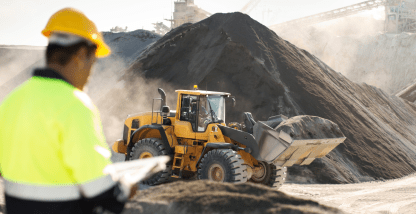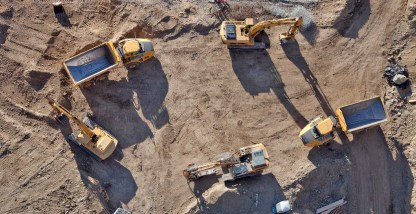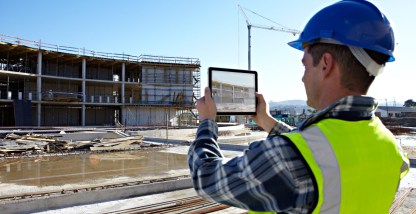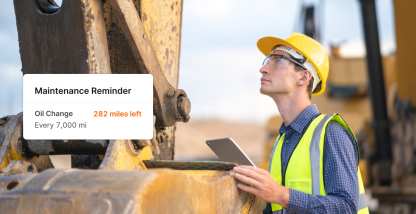Rising materials costs, a historic labor shortage, a fragmented supply chain. Challenges for the construction industry haven’t exactly been scarce. Adding to these issues is the exodus of 1 million workers that took place during the pandemic shutdown. Through it all, today’s firms have found ways to cope. Investments in technology have helped keep operations moving, and for many, these investments are starting to pay off.
An OpenAsset survey on current construction trends shows that of the 500 architecture, engineering, and construction professionals surveyed, 78% feel well-positioned to grow and 81% plan to implement technology in the near future. Respondents intend to use new technology to win business, meet deadlines, and be more productive.
“It’s exciting to see technology move into construction,” says Jason Janicki, Chief Operating Officer at OpenAsset. “The survey results show that construction companies are starting to change the way they work.”
Here are seven tech trends that are helping firms work better, faster, smarter.
1. The integration of ERP, CRM, and marketing automation tools
Enterprise resource planning (ERP), customer relationship management (CRM), and marketing automation tools. They’re all top of the list for contractors looking to work faster and smarter. But be forewarned, using these tools individually isn’t enough.
“Companies are looking for ways to integrate ERP, CRM, and marketing automation tools to become more efficient,” Janicki explains. “The construction industry is starting to move away from siloed systems that don’t talk to each other. As contractors compare tools and platforms, they’ll need to consider how new technology investments will fit with existing platforms.”
At Chicago-based Clune Construction, integration into client-facing platforms is underway. Clune has merged its ERP software with its CRM so that project managers, superintendents, and accountants can work together in one platform.
“We’re planning to push some of that information out to a client portal so that customers can see it too,” says Denise Moy Duffy, Clune’s Senior Vice President of Marketing and Communications. “Everything will be open and transparent for clients in terms of project management and finances. Customers will be able to see where each dollar is going in real time.”
“The point of ERP and CRM integration is to ensure that automated and consistent information is shared between both systems, creating a single source of truth,” writes Cleo, an integration cloud platform. “When an ERP and CRM are integrated, you have an accurate view of customer information once an order has been made.”
2. The Internet of Things (IoT), telematics, and optical character recognition (OCR) integration
IoT, telematics, and OCR are changing the way construction firms work, and they’re doing it together.
IoT is a network of devices connected to the internet and each other. When smartphones, wearables, and other devices communicate with each other through the internet, a safer, more automated workforce is possible.
IoT sensors can be integrated into a fleet management platform, allowing telematics to sort data more quickly. “This gives businesses near-real-time visibility into key metrics like fuel consumption, engine status, vehicle location, driver behavior, and vehicle maintenance history,” writes the technology content platform KnowledgeNile.
For example, with Motive’s ability to connect vehicles, drivers, and the corporate office, construction firms can streamline access to critical project information. When everyone is aligned on a project, it leads to better collaboration and productivity. And because Motive connects with virtually any third-party software vendor, fleets can reap the benefits of Motive while using their existing systems.
“Construction sites are seeing far more automation and digitization of the job site,” observes Christian Burger, President and Founder of Burger Consulting Group. “That’s what’s getting interesting about all this. We’re not just automating accounts payable, estimating, or billing anymore. We’re getting into much more of an environmental process, looking at job site productivity. That’s where the tech investment is going to have much bigger returns for construction.”
3. Tracking productivity
As job site productivity comes into focus, firms are relying on job tracking software to work faster. It’s helping them solve problems in real time, stay on schedule, and conserve costs.
“The construction industry has struggled to keep up with the production of units,” says Burger. “Whether it’s feet of conduit or cubic yards of concrete, we haven’t had good tools for productivity. Now technology is allowing us to capture production in the field, report it back, and give feedback to foremen in the field about how they performed that day. I’m encouraged by technology that tracks productivity. It’s one of the things that’s been missing, and it will help contractors almost immediately.”
Tools like Procore’s project management software or Raken’s production tracking software make it easy for firms to understand how efficiently crews are working. Teams can record labor hours, cost codes, and other details right from a mobile device. Tracking software can automatically calculate efficiency rates and time to completion, making it easier for firms to identify risks and solve problems early.
4. The shift to a hybrid workforce
Only 15% of OpenAsset survey respondents plan to return to the office full time, Janicki says. “That’s why ensuring that work gets done efficiently outside of the office, and collaborating with people inside and outside the office, is becoming very important in construction.”
As soon as Clune Construction employees knew they’d have to leave the office for the COVID-19 shutdown, the firm switched to Microsoft Teams, a platform that allows for workspace chat, videoconferencing, and file storage. At the time, Clune had an instant messaging service but no way to share documents or view items as a team.
“Because we were on Microsoft 365 and Sharepoint already, moving to another Microsoft product was easy,” Duffy says. “Tools that allow for remote and hybrid work will be vital for communications in the future, especially as new generations join construction teams.”
5. Monitoring job site safety
On today’s construction sites, productivity and safety go hand in hand. When companies compromise safety for productivity, it often comes at a hefty price.
“Thinking that safety can be ignored in production is akin to saying that efficiency and the cost of production don’t matter,” writes EHS Today magazine. “A safety mishap can impact both the volume and cost of production like few other things can. The small gains made in production by shortcutting safety seem to be worthwhile until an accident occurs. Then the gains disappear or even become losses in many cases.”
As construction firms note the close connection between safety, productivity, and profitability, an important trend has emerged. “Video monitoring for hard hats, fall protection, and safety vests is becoming more common,” Burger says. “Wearable devices are letting us know where workers are at any given time, so that if a track hoe is backing up, the operator knows that someone is behind it.” By detecting falls, monitoring body temperature, and sending alerts, wearables can also protect workers from overheating and fatigue.
Safety solutions that use artificial intelligence (AI) and computer vision are in demand for their ability to improve safety in real time. A Forbes article explains the impact AI is having on construction safety.
“Increasingly, construction sites are being equipped with cameras, IoT devices, and sensors that monitor many aspects of construction operations,” Forbes writes. Motive’s AI Dashcam, for example, empowers contractors to make informed decisions in the most critical moments. The AI Dashcam notifies contractors of unsafe driving actions as they happen so that drivers can take corrective action.
The AI Dashcam works to prevent accidents, safeguard lives, and reduce liability. As Forbes writes, “with facial recognition and object recognition technology, AI systems are capable of detecting unsafe behavior and alerting the construction team of potential hazards. Not only does this reduce liability, but it can save lives and increase efficiency.”
Another area where tech is improving safety is with wearables. “By integrating wearable devices and their data with cloud-based software, companies can facilitate instant communication between managers and field workers,” writes For Construction Pros magazine. Smartwatches, augmented reality glasses, and wearable sensors are improving workplace safety. Just as importantly, they’re opening critical lines of communication and revealing important data insights.
6. Digital asset management
Remote work is here to stay. Employees need an efficient way to manage assets, including videos, PDFs, and design files. When assets aren’t managed correctly, it can take hours for employees to find what they need.
“A digital asset management system is absolutely necessary when managing a hybrid or remote workforce,” Duffy says. “It adds a much-needed level of organization and accessibility to digital assets.”
The concise organization that digital asset management provides can be pivotal in protecting firms from litigation.
“Companies can really up their game when it comes to digital asset management,” Burger says. “The expense of legal discovery has plagued firms for a long time. If you don’t have good records management practices and systems to support record management, then getting a discovery notice can be a very expensive and risky proposition.”
Companies are realizing that poor organization of assets is a huge risk. Publicly traded firms have been faster to tighten up their records. “But private firms have been slow to get there,” Burger says. “The idea of content management was perhaps not foremost in their minds, and now with the explosion of digital content, content management is a priority.”
7. Hiring tech-savvy teams
Even with all the focus on equipment, Burger sees an emerging trend developing in construction staffing. Business analysts.
“About 10 years ago, the notion of a business analyst was seen as an overhead item and a luxury,” Burger says. “Today more companies are hiring them. The business analyst is basically a level of assurance that your investment in technology is actually going to provide significant returns. Business analysts can help build out training or testing material if need be. And yes, I would say it’s a full-time role.”
While Clune doesn’t have a business analyst, they have something equally important. A tech-testing committee.
Made up of about 80 volunteers from across the company, the volunteers sit on various committees to test technologies the company is considering. For example, someone on the Apple committee would test out iPhones, iPads, and new software updates.
Clune has teams that test augmented reality and virtual reality tech, software programs, and patches for ERP or CRM systems.
“If the technology is doing what we hope it will do, then the committee can push it out to the masses and talk about how much they like it,” Duffy says. “We’re building internal champions this way. It helps ease the fear of trying something new. Our employees know that someone has used it and understands how it works. So there’s always someone on the committee to go to for help.”
Are you looking to onboard new technology? Motive has a solution for you. Check out our website to see which Motive technologies best fit your construction business.










